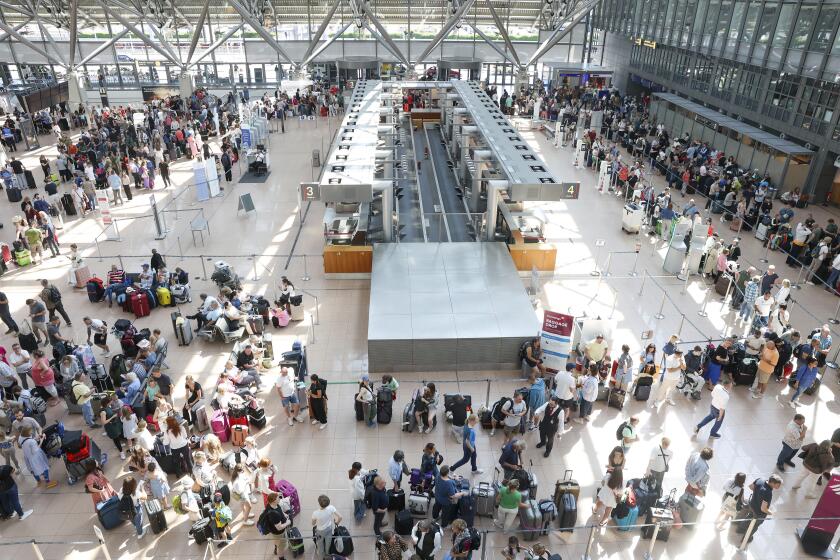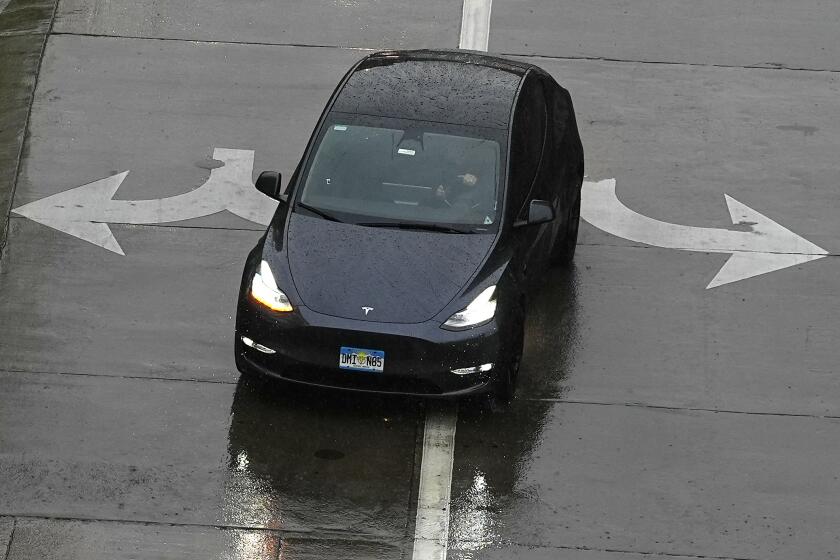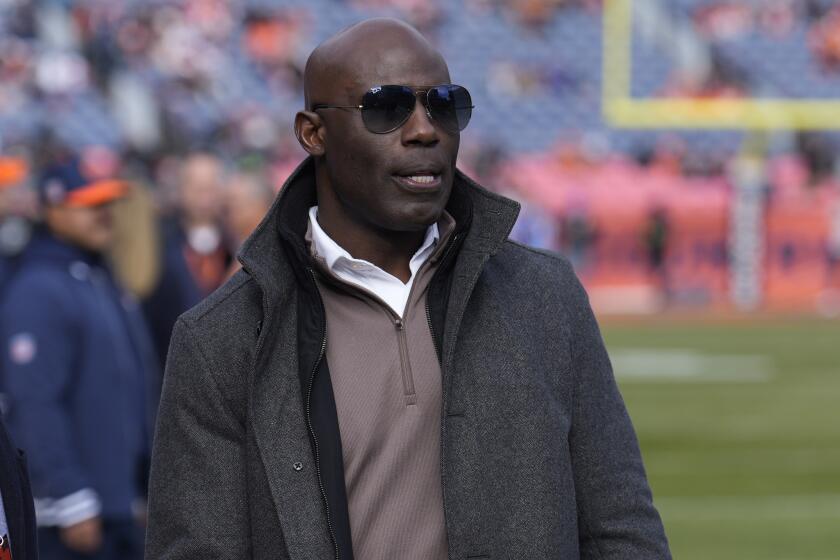The Going Gets Tough if You’re a Victim of : LOST BAGGAGE : It’s Every Passenger’s Nightmare, but Airlines Say the Losses Are Few
Thomas LaFlam, a 27-year-old electronics technician, learned his lesson the hard way. On his way to Burlington, Vt., from San Diego, he checked his video camera with Continental Airlines. Although he made it to Burlington, his equipment did not, and he expected Continental to compensate him $1,200 for the lost camera.
To his frustration, Continental refused, saying it is not responsible for lost photographic equipment. “They told me I should have bought a seat for the camera,” LaFlam said.
LaFlam is among 2.4 million passengers whose baggage was lost by U.S. airlines last year. The airlines contend that the problem is small because less than 1% of airline passengers lose their bags. And, the airlines say, most lost baggage is found within hours.
Airline executives say there are dozens of reasons baggage gets lost. The most common, they say, is a missed flight connection. United Airlines customer service Vice President Steve Steers said 50% to 60% of lost baggage claims can be blamed on missed connections.
But there are many losses for which the airlines are not responsible. Some items get sidetracked even before their owners get to the boarding area.
Major Inconvenience
Security guards at Los Angeles International Airport regularly confiscate seemingly innocent letter openers and pocket knives from passengers’ pockets, purses and briefcases because they could be used as weapons.
In other cases, passengers leave sweaters, hats, shopping bags, wallets and passports behind in restrooms and waiting areas. The LAX lost-and-found department is brimming with them, and “the list goes on and on,” said Melvin Tarver, an LAX security officer.
But the main problem is baggage lost by the airlines, and it is a major inconvenience. Without his video camera, LaFlam, a San Diego resident, was unable to film his visit to his parents’ Vermont home, or his side trip to Niagara Falls, N.Y. “I took still pictures,” he said, “But it’s not the same.”
Lost baggage has spawned a number of baggage delivery businesses at airports. At LAX, four companies under contract with the airlines deliver mishandled baggage to passengers. One company, Amlock, has delivered late-arriving surfboards and tropical fish to airline customers in the Los Angeles area.
“It was very difficult during the Night Stalker killings,” said one Amlock executive, referring to the series of 1985 murders in Los Angeles and Orange counties. “No one wanted to open their doors.”
Some industry observers say airlines are improving at handling baggage. Aviation Consumer Action Project director Christopher J. Witkowski, for one, attributes improved service to a U.S. Department of Transportation order 1 1/2 years ago that requires airlines to file monthly lost-baggage reports.
Compensation Usually Offered
The reports are available to the public, so consumers can judge an airline’s performance. “No one wants to be at the bottom of the list,” Witkowski said.
When lost baggage cannot be found, airlines usually offer compensation. On domestic flights, they normally pay up to $1,250, depending on the value of the lost baggage. On international flights, airlines are required under the Warsaw Convention to pay compensation totaling at least $9.07 a pound. That works out to $181.40 for a 20-pound suitcase.
The question of compensation can be tricky, because airline policies differ. Most airlines will not pay for lost jewelry, cameras or computer equipment, but some, such as USAir, allow travelers to buy extra insurance for valuables.
As LaFlam discovered, airlines do not go out of their way to warn passengers of the risks. To learn Continental’s policy on lost cameras, LaFlam would have had to ask a ticket agent for a “contract of carriage,” a document that details the airline’s liability.
Airlines say the subject of compensation rarely comes up because most lost bags are found. More than 90% of lost bags are found and shipped to the correct destination within hours, according to United’s Steers. Only 1% of misplaced baggage is permanently lost, he added.
Although missed flight connections are the major reason for lost baggage, there are other causes. Steers said baggage is lost in many cases because ground crews load bags on the wrong plane or fail to load all the baggage on a plane. In those cases, he said, baggage can be retrieved quickly.
But even when bags are found quickly, the experience can be infuriating. Laurie Sandow, a 36-year-old Brooklyn, N.Y., judo enthusiast, lost her luggage on a United flight to San Francisco from Newark, N.J. Despite her fatigue, Sandow said she could not sleep until her suitcase was delivered the next morning. It contained her judo uniform, which she needed for a match that afternoon.
“It was fairly unpleasant--to say the least,” she recalled.
When a bag is missing for more than 24 hours, most airlines advance customers a small amount of cash to buy essentials, such as a toothbrush or underwear. United sometimes offers customers compensation if lost baggage does not arrive on the next flight, usually within three hours. “If it’s a case of lost skis, we’ll authorize funds for the customer to rent skis until the skis are found,” Steers said.
Airlines’ procedures for handling lost baggage vary. Generally, when a bag is found and the owner cannot be identified, it is stored for three to five days at the airport where it was found. If it is not claimed, it is shipped to the airline’s central warehouse, where it is stored for 30 to 90 days. If it is still unclaimed, the suitcase and its contents are sold to a salvage company.
USAir spokeswoman Agnes Huff said when a lost bag arrives at USAir’s warehouse in Pittsburgh, it is opened and an inventory of the contents is taken. The description is entered in a central computer used by airlines to share information on lost baggage claims. If there is a match, the bag and its contents are returned to their owner.
Airline executives say some items that end up at the warehouses are surprising. United’s Steers said the airline’s Chicago baggage depot contains many shelves filled with eyeglasses, briefcases, suitcases, coats, skis, tennis rackets, dictating machines, car keys--even a wooden leg. “I don’t know how someone can leave their leg behind, but it happened,” he said.
Tarver, the LAX security officer, said he’s had his share of unusual items, including a rack of designer dresses left behind by a clothing manufacturer and a wooden spear taken from a UC Berkeley professor before she boarded her plane. Security officers said the spear could have been used as a weapon.
Besides letter openers and pocket knives, the LAX lost and found department has an ample supply of tear gas spray confiscated from airline passengers. Each month, LAX turns over about 200 unclaimed items, such as hats and wallets, to the Los Angeles Police Department, which auctions them to the public.
Consumer advocates warn that it is important to follow carefully the airline’s procedures for making a claim for lost baggage. Generally, if claims are not made within 30 days, a consumer might receive no compensation even if the bag is never found.
COMPLAINTS ABOUT BAGGAGE HANDLING Mishandled baggage complaints by airline per 1,000 passengers during 1988.
Total Complaints Airline Complaints per thousand 1. Southwest 63,000 3.7 2. Pan Am 27,400 3.8 3. Alaska 30,000 6.0 4. Eastern 211,000 6.3 5. Northwest 229,400 6.9 6. USAir 236,000 7.0 7. American 441,000 7.1 8. Am. West 92,100 7.2 8. Continental 268,500 7.2 9. Delta 428,400 7.4 10. United 432,800 7.5 11. Piedmont 255,100 9.1 12. TWA 244,300 10.8
Source: U.S. Department of Transportation
More to Read
Inside the business of entertainment
The Wide Shot brings you news, analysis and insights on everything from streaming wars to production — and what it all means for the future.
You may occasionally receive promotional content from the Los Angeles Times.






